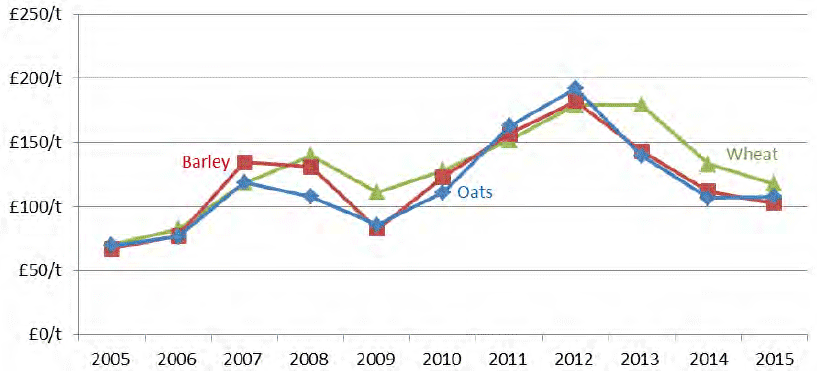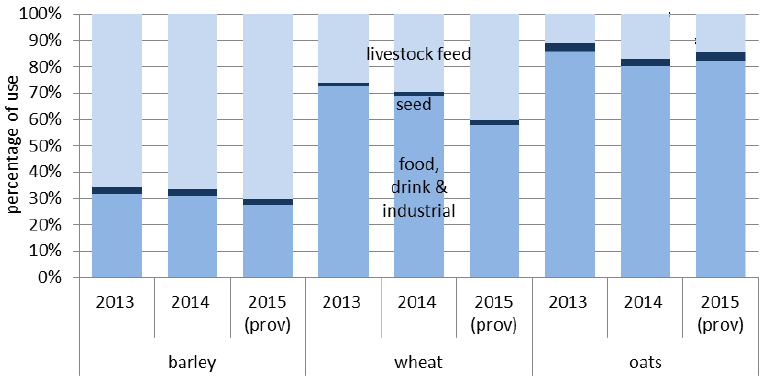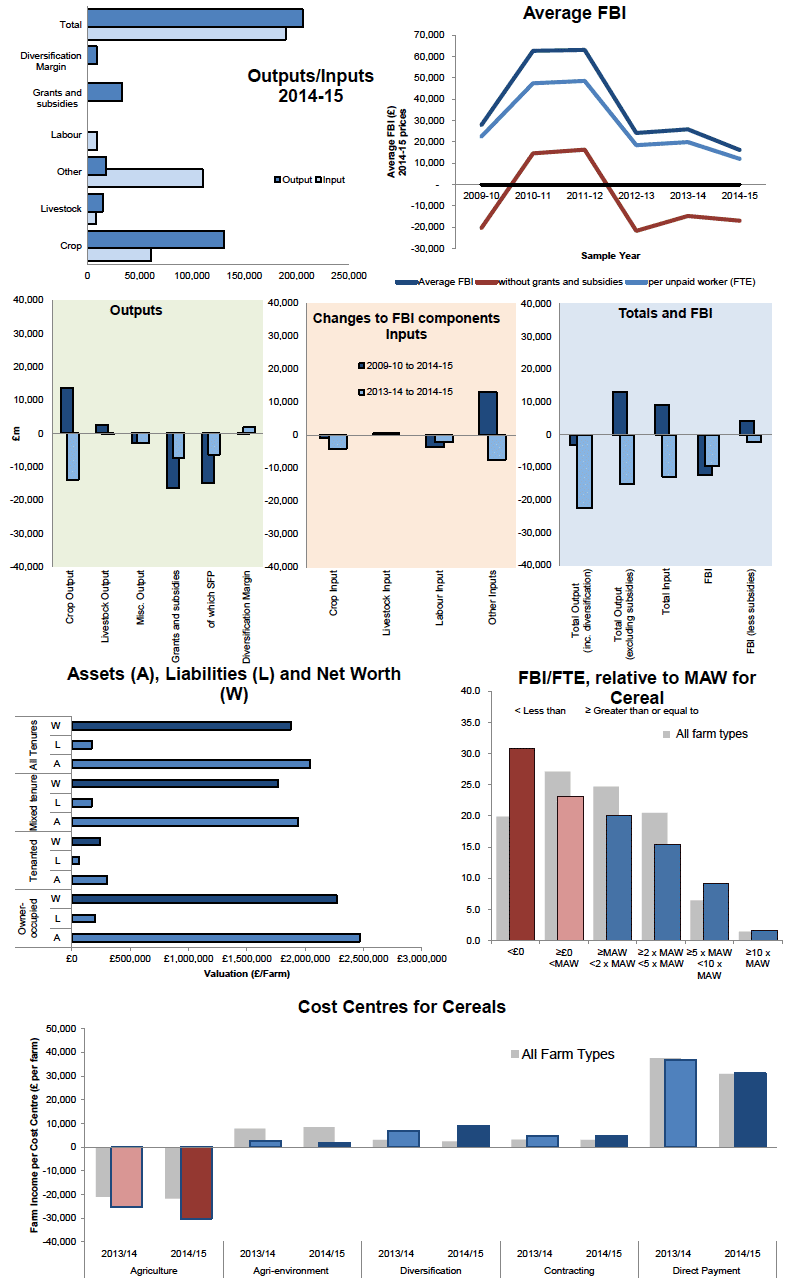Economic Report on Scottish Agriculture, 2016
Presents an overall picture of Scottish agriculture using data from the various agricultural surveys that RESAS manage.
4.2 Cereals
4.2.1 Income from cereals ( Table A3)
Cereals account for about 13 per cent of total farm output, an estimated £334 million in 2015 and around 43 per cent of the output from crops in general.
Chart 4.5 shows trends in the average annual output prices for cereals, used in the TIFF valuation. It is important to note that these calendar year prices span two crop production years and represent the value of cereals when they are used or sold off the farm. They also represent an average across different types of cereals used for animal feed, seed, human consumption and industrial purposes. These prices, which are obtained from the HGCA (Home Grown Cereals Authority) incorporate tonnages sold on forward contracts as well as cereals sold at spot prices.
Cereal output prices were relatively stable between 2005 and 2006, before increasing substantially in 2007 and remaining high in 2008. They then dropped quite markedly in 2009 before three years of increases. After peaking in 2012 at £180 to £190 per tonne, prices have fallen to about £100 (barley), £110 (oats) or £120 (wheat) per tonne, reflecting global trends in supply and demand of cereals.
Chart 4.5: Annual average output prices for cereals 2005 to 2015

Chart 4.6 shows the utilisation of cereals for different purposes. In 2015, the majority of barley (70 per cent) was used for animal feed, whilst the majority of wheat (58 per cent) and oats (82 per cent) was used for human and industrial purposes.
Chart 4.6: Cereal utilisation: 2013 to 2015

In 2015, total value of cereal output fell by 44 million (down 12 per cent), compared to 2014, following a previous decrease of £48 million (11 per cent) between 2013 and 2014. The output value of barley fell by £34 million (down 15 per cent), due to a combination of £9 per tonne (eight per cent) decrease in price and a 149,000 tonne (seven per cent) decrease in production. The output value of wheat decreased by £10 million (eight per cent), due to a £15 per tonne (12 per cent) decrease in price, despite a 30,000 tonne (three per cent) increase in production. The value of oats remained relatively unchanged due to only very few change in both production figures and prices.
4.2.2 Cereal farms FBI ( Table B1)
Accounting for inflation, between 2009-10 and 2014-15 the average FBI of cereal farms decreased by around 43 per cent, and by 74 per cent from the peak in income of £63,000 between 2010-11 and 2011-12. This was due largely to the decreased value of crop revenues and subsidy payments.
In the last year, both spending on inputs and revenue for cereal farms have decreased. As revenue saw a larger decrease at the same time as a fall in subsidy payments, this resulted in an overall decrease in income for 2014-15 to leave the FBI value of cereal farms at £16,000.
The average FBI/ FTE for cereal farms of £12,000 is roughly equivalent to an hourly wage for unpaid labour of £6.37, equivalent to 91 per cent of the minimum agricultural wage in Scotland. Around 54 per cent of cereal farms generated incomes equivalent to less than the minimum agricultural wage ( MAW), whereas 11 per cent generated more than five times MAW.
At £66,000, on average, high performing cereal farms generated incomes roughly four times the overall average. Low performing farm businesses made an average loss of £32,000.
Cereals Farms

The total average revenue for cereal farms, including income from diversification and subsidy payments, was £206,000. Spending on inputs averaged £190,000. The largest portion of the input costs was due to other inputs such as machinery, land and buildings and fertilisers.
Over the last three years, FBI without subsidy payments has been a loss. Over the six-year series this figure ranged from a loss of £22,000 in 2012-13 to a profit of £16,000 in 2011-12. Over the last year, FBI without subsidy payments has slightly worsened to a loss of £17,000.
Over the last year, cost centres for cereal farms show a small increase in income from diversification, but decreased income from agricultural activities and direct payments. There has been little change to the income from agri-environment and contracting activities.
The average net worth (assets minus liabilities) of cereal farms was £1.9 million in 2014-15. The average debt ratio (liabilities:assets) remained unchanged at eight per cent for cereals farms but ranged between eight per cent for owner-occupied and 19 per cent for tenanted farms.
Contact
There is a problem
Thanks for your feedback